Common Grounds
Israel’s PM is playing with fire on the Temple Mount
Source: The Times of Israel
By DAVID HOROVITZ
Published July 19, 2021
Bennett hailed ‘freedom of Jewish worship’ at the religious hotspot, a day after TV footage showed Jews at prayer there. Then he backtracked, anonymously. This is no way to govern
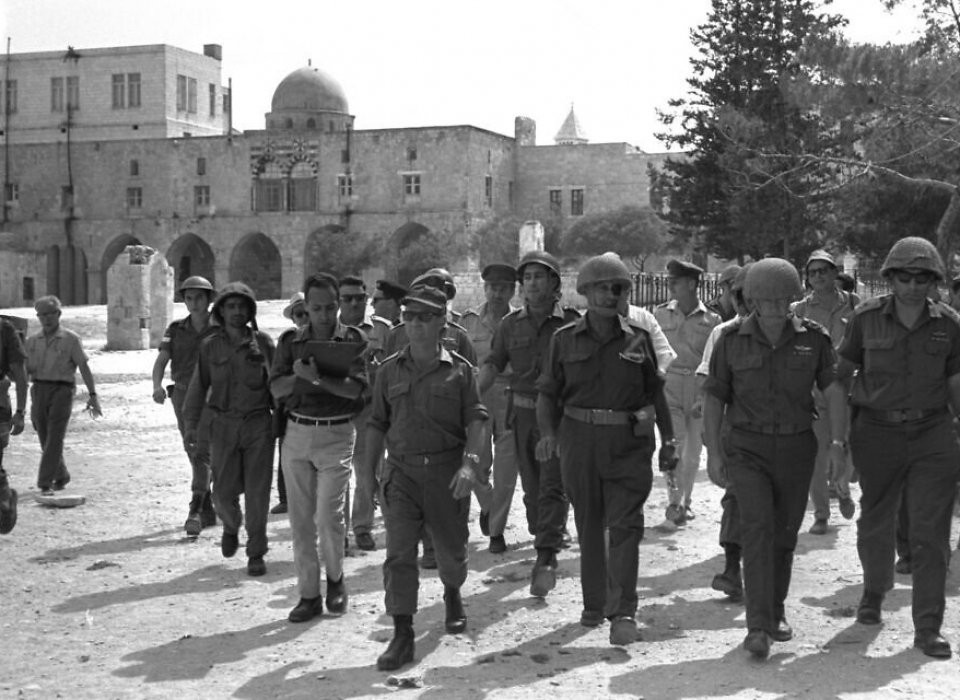
Moshe Dayan at the Temple Mount, June 7, 1967 (Ilan Bruner / GPO)
Less than two weeks after 55th Paratroopers Brigade commander Lt. Gen. Mordechai (Motta) Gur announced that “the Temple Mount is in our hands” at the culmination of 1967’s Six Day War, Defense Minister Moshe Dayan determined that actually, in terms of religious authority, it wasn’t.
At a meeting with Muslim religious leaders atop the Mount on June 17 that year, agreement was reached on a so-called reformulated status quo under which the Jordanian Muslim Waqf would continue to hold religious responsibility for the compound under overall Israeli supervision; prayer on the Mount would be reserved for Muslims only; Jews would be allowed to visit but not to pray there.
This constituted a strikingly radical decision. Having finally regained sovereignty in a bitter defensive war over the holiest place in Judaism, the site of the two biblical Temples, here was the defense minister of the revived Jewish state promptly relinquishing the Jews’ right to practice their religion there.
Dayan was, pragmatically, seeking to tamp down the post-war frictions with the Muslim world, for which the Al-Aqsa Mosque atop the Haram al-Sharif is the third-most holy shrine. And he was utilizing the halachic ban on Jews so much as setting foot on the Temple Mount for fear that they might inadvertently desecrate the area where the Temple’s Holy of Holies, its inner sanctuary, had stood. The Temple Mount was in Israel’s hands, but the Jews’ holiest place for prayer would remain the Western Wall, the retaining wall of the compound, beneath it.
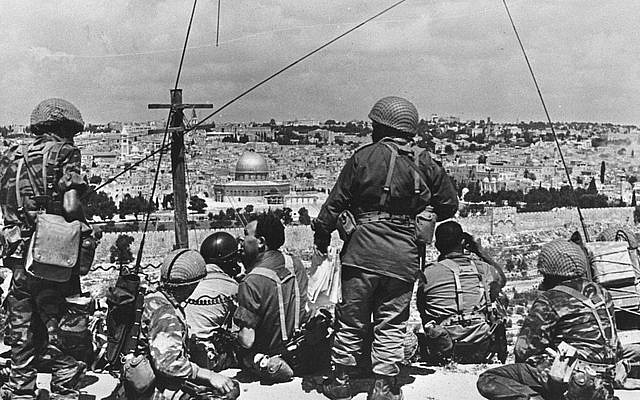
Mordechai Gur (seated, with black curly hair) and his troops survey the Old City before launching their attack in the 1967 Six Day War (photo credit: Wikimedia Commons CC BY-SA/Mazel123)
Over the decades, Israel’s pragmatic forbearance has often been turned against it. The fact that the Jewish state did not insist on asserting the fullest sovereignty over the Temple Mount, emphatically including religious rights, has been seized upon by its demonizers to argue that self-evidently the area is not of paramount importance to the Jews, and by extension that the Jews are not genuinely connected to this land at all. Whereas a century ago, the historicity of the biblical Temples was axiomatic in Islam — the mosques atop the mount were built precisely to demonstrate Islam’s ostensible preeminence over Judaism — now it is increasingly denied, even ridiculed, including notably by the president of the Palestinian Authority, Mahmoud Abbas, who has declared that the entire Zionist project is a colonial enterprise unrelated to Judaism.
Many in Israel have bristled with increasing frustration against the ban on Jewish prayer at the Mount in recent years. Rabbinical opposition has been gradually fragmenting and Orthodox nationalist activists have pushed against the restriction. The bitterness has been exacerbated by episodes of archaeological desecration on the part of the Waqf.
But Israeli governments, of all political hues, have nonetheless declared their commitment to the status quo, concluding that the fragile balance of forces in this region requires its maintenance. Notably, in 2015, amid one of the innumerable flare-ups of tension surrounding the site, prime minister Benjamin Netanyahu specifically assured Jordan — the nation from which Israel had captured the Old City in 1967, and now the peace partner with which Israel shares its longest border — that Israel would not allow Jewish prayer on the Mount. “Israel will continue to enforce its longstanding policy: Muslims pray on the Temple Mount; non-Muslims visit the Temple Mount,” Netanyahu promised.
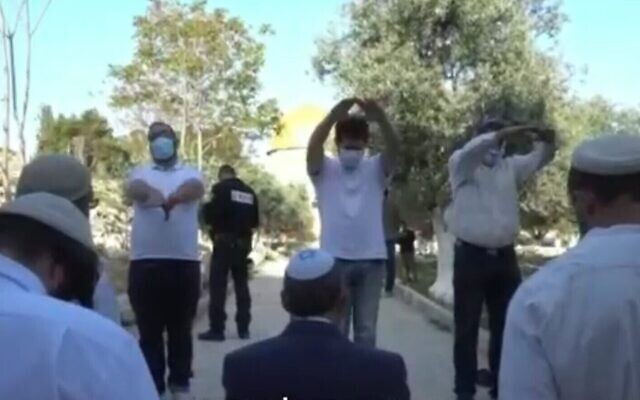
Jewish prayer on the Temple Mount, as reported by Channel 12 news, July 17, 2021. (Channel 12 screenshot)
In recent months, however, the Israeli authorities have presided over a quiet “revolution, unfolding under the radar,” under which Jewish prayer on the Mount is sometimes tolerated, a Channel 12 TV report showed on Saturday night. Whereas in the past, Jewish visitors would be removed from the compound for merely muttering a few worshipful words, and tour guides could be asked to leave for quoting Jewish liturgy in the course of their explanations, a minyan (10-strong prayer quorum) has for months been holding morning prayers atop the Mount, not far from the golden Dome of the Rock, under the tolerant gaze of Israeli police, the TV report revealed, and lengthy Jewish study classes have also been permitted.
On Sunday, Tisha B’Av, the fast day that marks the destruction of both Temples and a succession of other black moments in Jewish history, some 1,700 Jewish visitors were allowed onto the mount, in a typically tense atmosphere that saw minor early-morning clashes between Palestinian protesters at Al-Aqsa and police, and subsequent denunciations of any and all Jewish visits to the site by Jordan, Egypt, Turkey and the Israeli government’s own Arab coalition member, the Ra’am party.
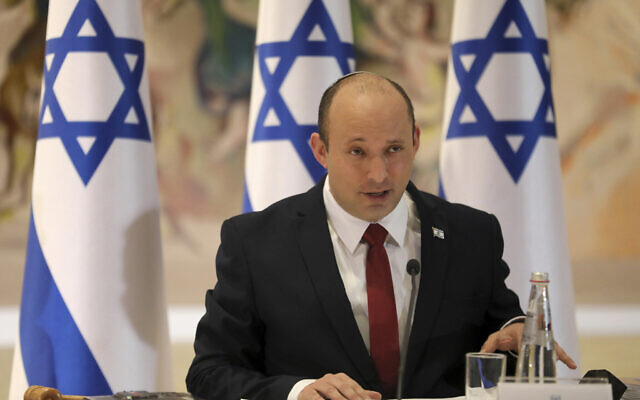
Prime Minister Naftali Bennett chairs the weekly cabinet meeting in Jerusalem Monday, July 19, 2021. (Pool Photo via AP)
Pleased that the day’s high-tension visits had passed off with relatively little trouble, Prime Minister Naftali Bennett on Sunday afternoon issued a statement, in Hebrew and in English, thanking the security authorities “for managing the events on the Temple Mount with responsibility and consideration, while maintaining freedom of worship for Jews on the Mount [italics added]. Prime Minister Bennett emphasized that freedom of worship on the Temple Mount will be fully preserved for Muslims as well, who will soon be marking the fast of the Day of Arafah and the Eid al-Adha.”
But of course, under the status quo, there is no “freedom of worship for Jews on the Mount.”
The Times of Israel immediately sought clarification from the Prime Minister’s Office. Coming a day after the Channel 12 footage of Jewish prayer on the Mount tolerated by the police, was Bennett, who heads the Orthodox-nationalist Yamina party, indicating that the arrangement put in place by Moshe Dayan in 1967 was now at an end?
The Temple Mount is arguably the world’s most combustible piece of real estate. To give just two recent examples, Palestinian terrorists unleashed the Second Intifada in 2000 using the pretext of opposition leader Ariel Sharon’s visit to the compound; the latest Israel-Gaza conflict, in May, was launched by Hamas capitalizing in part on tensions relating to the Mount. Given the extreme sensitivities, one might have expected a rapid clarification from the Prime Minister’s Office on Sunday: Yes, the new Israeli government is changing its policy. Or, no, the statement was incorrectly worded and will be amended and reissued.
Neither of those things happened. Asked what was going on, Israel’s minister of public security, Labor’s Omer Barlev, appeared on television on Sunday evening to declare that the status quo has not changed, that Jewish prayer at the site remains illegal, and that Bennett’s office had apparently “misworded” its statement. The PMO had meant to say “freedom of movement” for Jews on the Temple Mount, Barlev suggested, not “freedom of worship.”
From the Prime Minister’s Office itself, however, there was silence.
On Monday morning, Army Radio quoted “unnamed sources” in the prime minister’s circle declaring that the statement had been “incorrectly formulated.” Contradictorily, however, the same Hebrew report said Bennett had “backtracked from his declaration of freedom of worship for Jews on the Temple Mount” in the wake of “criticism from within the coalition.”
And, officially, from the Prime Minister’s Office, as of this writing — hours before Jordan’s King Abdullah, incidentally, is due at the White House for talks with US President Joe Biden — still nothing. No corrected statement has been issued. The original statement, highlighting “freedom of worship for Jews on the Mount,” remains unamended on the prime minister’s official Hebrew and English social media accounts.
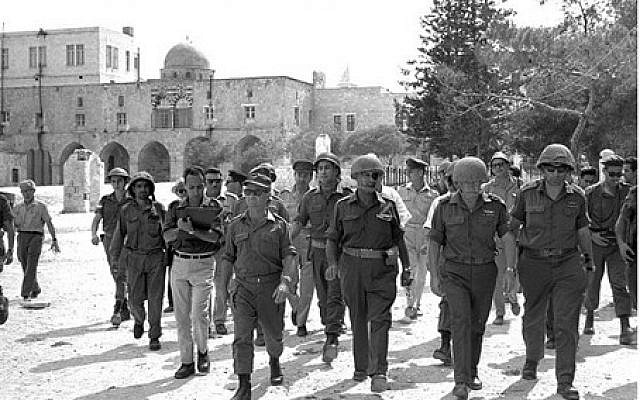
Moshe Dayan at the Temple Mount, June 7, 1967 (Ilan Bruner / GPO)
The decision Moshe Dayan made on June 17, 1967, can of course be legitimately examined and debated by the Israeli government. But any shift in policy would have far-reaching implications. Changing the status quo at the Temple Mount is not a move to be considered lightly.
Turning an official blind eye to Jewish prayer at the site, then issuing statements appearing to endorse it, then anonymously backtracking while leaving the formal statements unamended, is a case of playing with fire at a uniquely incendiary flashpoint. Bennett needs to clarify his position — rapidly and responsibly.
LATEST OPEN LETTERS
-
06-01Standing in Solidarity with the People of Venezuela
-
21-07Freedom
-
20-03Stand up to Trump
-
18-02Average Americans Response
-
23-12Tens of thousands of dead children.......this must stop
-
05-06A Call to Action: Uniting for a Lasting Peace in the Holy Land
-
28-05Concerned world citizen
-
13-02World Peace
-
05-12My scream to the world
-
16-11To Syria and Bashar al-Assad
VIRTUAL POST OFFICE
PETITIONS
LINKS
DONATION
Latest Blog Articles
-
13-01From Gaza to Venezuela, the US has been unmasked as the serial villain
-
13-01Analysis Trump Isn't Fostering a Cease-fire Deal – He's Washing His Hands of Gaza
-
13-01Opinion | The Death of 'The Good Arab'
-
12-01The Evangelical Pope | Navigating With a Guiding Hand
-
09-01Our Friday News Analysis | What the World Reads Now!
-
07-01Our Wednesday News Analysis | US Attack on Colombia, Venezuela: Six Takeaways from Dan Kovalik’s Interview
-
06-01US Attack on Colombia, Venezuela: Six Takeaways from Dan Kovalik’s Interview
-
06-01The Harder Hope Becomes, the More Urgent It Is: A Reckoning for Israelis and Palestinians in 2026
-
06-01As the world welcomes a new year, we, in Gaza, dread what it will bring
-
05-01The Evangelical Pope | The Message of Christmas
-
31-12Our Wednesday News Analysis | The World Radicalized by the Gaza Genocide
Latest Comments
 One of the most important and illuminating articles that I …
One of the most important and illuminating articles that I …
Comment by Benjamin Inbaraj And what's wrong here?
After all, there is the homeland …
And what's wrong here?
After all, there is the homeland …
Comment by Isac Boian Does this reinforce or deny my argument that Israel is …
Does this reinforce or deny my argument that Israel is …
Comment by Edward Campbell Many 'say' they support the Palestinian cause but do little …
Many 'say' they support the Palestinian cause but do little …
Comment by Philip McFedries The UN is strangled by the "war for profit" cabal …
The UN is strangled by the "war for profit" cabal …
Comment by Philip McFedries I can't read the printing on the map.
I can't read the printing on the map.
Comment by Philip McFedries Good news!
Good news!
Comment by Philip McFedries

COMMENTS
This article has 0 comments at this time. We invoke you to participate the discussion and leave your comment below. Share your opinion and let the world know.